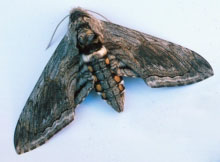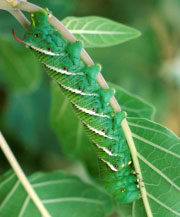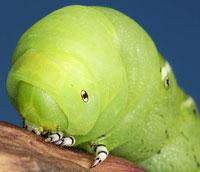show/hide words to know
Instar: stages in the growth of a larva.
Metamorphosis: dramatic change in body form... more
Molt: to shed the outer layer of the body.
Pupa: resting stage during which tissues are reorganized from larval form to adult form. The pupa is the third body form in the life cycle of insects that undergo complete metamorphosis (like caterpillars).
By Karla Moeller
Illustrated by Sabine Deviche
What’s a Manduca?

“Giant baby is bigger than its parents!” may make a great cover story for a magazine that publishes fake news, but in the world of moths and butterflies, it isn’t unusual for the juvenile caterpillar to weigh more than the adult moth or butterfly.
One such insect is Manduca sexta, also known as the tobacco hornworm or hawkmoth. In this species, juveniles weigh almost five times as much as the adults. It has four main life stages: the egg, the juvenile or larva, the pupa, and the adult. Between these four life stages, the hornworm makes some astounding changes in size and form.

Egg, photo by Art Woods
From tiny beginnings
Hornworm eggs start out at a tiny 1 millimeter in length—about the size of a pen tip. The eggs take a couple of days to hatch into larvae, and then the magic begins. Over a short three weeks, a hornworm will grow from about 0.01 grams to 12 grams. That is more than a 1000-fold increase in mass, about the same as if a housecat grew to the size of an elephant!

Hornworms grow more than 1000 times larger in mass, the same as if a housecat grew to the size of an elephant!
Room to grow
During this period of speedy growth, the tobacco hornworm will shed its waxy skin, or cuticle, four times. This process is called molting and allows the larva to continue growing. Without molting, the cuticle would be too small, and the larva wouldn’t be able to grow—this would be like wearing shoes too small for you that stunt the growth of your feet.
Ready for change
The growth period between molts is called an instar. The larval stage consists of five instars (four molts). During the final instar, the larva prepares for metamorphosis, the process by which the tobacco hornworm caterpillar is transformed into an adult hawkmoth. Once the caterpillar reaches a large enough mass called the critical weight, the process that will trigger metamorphosis begins.
Metamorphosis

Manduca pupae, photo by Art Woods
First, the caterpillar goes into a “wandering stage”, where it stops eating and searches for a site to transform or pupate. Pupation is the process of forming a hard brown shell, similar to a cocoon. This shell protects the tissues inside the pupa that are involved in the transformation from a caterpillar to a moth. During this process, the pupa will not be able to move. To stay safe from predators that might eat them, caterpillars will often wander into a hole in the ground to pupate.

Adult Manduca after metamorphosis, photo by Art Woods
Hornworm metamorphosis takes approximately three weeks, after which the moth emerges. During pupation, the 12 gram caterpillar is transformed into a 2 or 3 gram adult moth. The newly hatched adults mate during their nocturnal activity and the females deposit their eggs on the underside of tobacco plants. Then the cycle begins all over again.
The role of temperature
For insects such as the hornworm, temperature has a large effect on growth, be it through changing the rate of growth or the time over which an animal grows, including the timing of metamorphosis. This means that a world that is warming or cooling could mean a lot of changes for temperature-dependent animals like insects.
Scientists are currently trying to learn about how the changes in climate that are occurring may affect animal development and survival. This is especially important for insects like the hornworm.
Caterpillar models

Photo by Art Woods
In a world filled with small caterpillars, having such a large body that is affected by temperature makes hornworms useful for scientific research. All of their tissues are larger and easier to see or work with, and they are easy to raise and handle in a laboratory setting. Most importantly, hornworms can help us learn about the effects of temperature and climate change on animal development and the timing of life cycles.
All of these characteristics have made the hornworm a species that is very useful for learning about other insects. This has made them what we call a “model organism.” This doesn’t mean that they pose for pretty pictures (although their bright green color does make for great photos), but it means that hornworms are an insect that we can easily use to learn more about insects and climate change in general. Seems like a pretty big job for such a big baby.
View Citation
Bibliographic details:
- Article: What's A Manduca?
- Author(s): Dr. Biology
- Publisher: Arizona State University School of Life Sciences Ask A Biologist
- Site name: ASU - Ask A Biologist
- Date published: December 28, 2016
- Date accessed: April 17, 2024
- Link: https://askabiologist.asu.edu/manduca/introduction
APA Style
Dr. Biology. (2016, December 28). What's A Manduca?. ASU - Ask A Biologist. Retrieved April 17, 2024 from https://askabiologist.asu.edu/manduca/introduction
Chicago Manual of Style
Dr. Biology. "What's A Manduca?". ASU - Ask A Biologist. 28 December, 2016. https://askabiologist.asu.edu/manduca/introduction
Dr. Biology. "What's A Manduca?". ASU - Ask A Biologist. 28 Dec 2016. ASU - Ask A Biologist, Web. 17 Apr 2024. https://askabiologist.asu.edu/manduca/introduction
MLA 2017 Style

Be Part of
Ask A Biologist
By volunteering, or simply sending us feedback on the site. Scientists, teachers, writers, illustrators, and translators are all important to the program. If you are interested in helping with the website we have a Volunteers page to get the process started.









